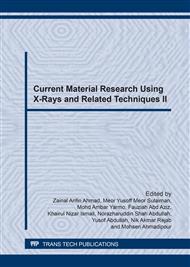p.485
p.491
p.496
p.503
p.508
p.513
p.518
p.524
p.529
Effect of Pressure on the CO2 Absorption into Ladle Furnace Slag
Abstract:
Carbon dioxide (CO2) is one of the greenhouse gases (GHG) and the concentration is much more higher than other GHG gases. Based on the prediction, about 285.73 million tonnes will be emitted in year 2020 with the main contributors are from power generation, manufacturing industries, transportation and residential sector [1]. This research focused to study the effect of pressure on the CO2 absorption with Malaysia steel slag using mechanical stirrer. The steel slag is collected from one of steel industry located in Pasir Gudang Johor Malaysia and characterized to investigated the chemical composition. The reaction between CO2 absorption and the slag was investigated by using different speed and weight. The initial pressure was set at 101.3 kPa which equivalent with 1 atmospheric pressure. The behavior of the reaction between CO2, and ground sample was investigated by measuring the change in the CO2 pressure inside the mechanical stirrer. It was found that the CO2 pressure decreased as soon as the stirrer started and continuously decreased till bout 270 t/min stirring time.
Info:
Periodical:
Pages:
508-512
Citation:
Online since:
March 2017
Keywords:
Price:
Сopyright:
© 2017 Trans Tech Publications Ltd. All Rights Reserved
Share:
Citation:


